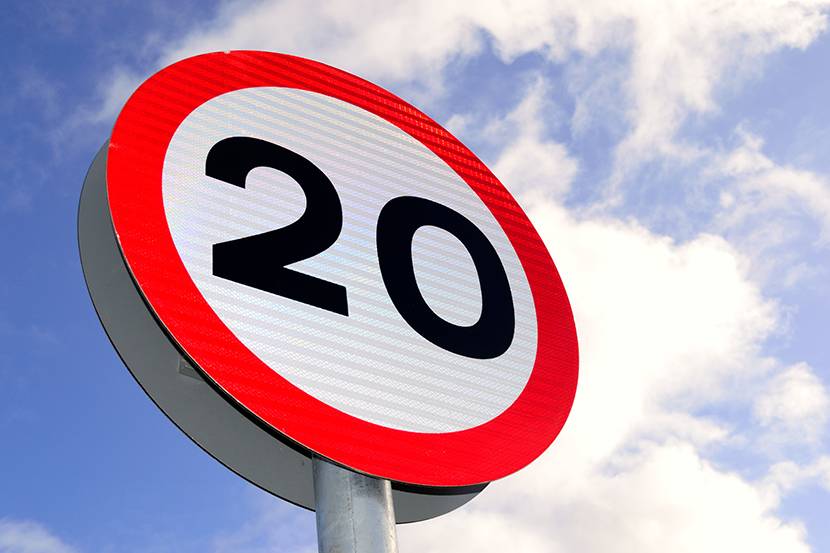20 mph zones are now in most residential areas in Wales and Scotland. Soon, they could be more common in England.
Wales introduced a blanket reduction to speed limits in most residential areas on 17 September 2023, but some roads are going to stay at 30 mph.
They’ve been met with mixed reviews from the public and some 20 mph signs have even been vandalised. But according to a survey in Wales 63% said they’d support a lower speed limit where they live.
We look at where the 20 mph zones are in the UK, and what they mean for motorists.

Our research
20 mph limits have become a contentious issue, so we asked a group of over 700 motorists to offer their thoughts on the 20 mph zones. We asked them:
-
What do you think about the 20 mph zones?
-
Have you noticed people tailgating you in 20 mph zones?
-
Do you think people are following the 20 mph speed limits?
-
Have you noticed congestion in your area since the government introduced the 20 mph zones?
-
Do you have any other comments about the 20 mph zones?
Why is the government introducing 20 mph zones?
The government is introducing these zones to improve safety in residential areas. It could also reduce emissions and improve air quality in these areas. The 20 mph zones in Wales are mostly in villages and town centres. Online, you might see them referred to as restricted roads. The Welsh government said that the 20 mph zones could mean that every year there are:
-
40% fewer collisions
-
6 to 10 people’s lives saved
-
1200 to 2000 people avoiding injury
The reduction could also make it safer for ‘active travel’ like walking and cycling. The Welsh government goes on to say that the 20 mph zones could:
-
Make streets safer for children who are playing
-
Improve safety within communities
-
improve health and wellbeing
The zones could also reduce noise pollution. In fact, 34%** of drivers say that car noise is one of the most annoying driving habits.
Another benefit of the 20 mph zones is that it could positively impact car insurance premiums.
What our motor insurance expert says:
“The government has implemented the 20 mph changes in both London, Scotland and Wales. Opinions on the 20mph zones are divided, as some drivers feel frustrated with the changes. But a slower speed limit can benefit the environment and be safer for road users. This can be especially important for built up areas, such as congestion zones or near schools and hospitals.
"The speed reduction could also have a positive impact on car insurance prices. A lower speed limit could mean less accidents, which means less claims. So eventually, the 20 mph zones could help reduce premium prices overall.”

This isn’t the only change to encourage active travel. In 2022, the Highway Code changed to prioritise vulnerable road users like cyclists, horse riders and pedestrians. One of the rules is drivers must give way to pedestrians when they're crossing at a junction. Motorists also have to give cyclists at least 1.5 metres of room when overtaking.
For those who've had a 20 mph zone in their area, we asked them what they thought of the change:
“So far, I don't have an issue, the roads that have been changed seem mostly to be sensible ones in residential areas.” Sean, 55
“Around schools and side streets, then 20mph is more than adequate and sensible.” Annette, 49
“All for it. If it creates a safer environment for our communities and saves lives, then it's a no brainer. I understand people's frustrations when behind the wheel, but I think when looking at the bigger picture, adding a few more minutes to a journey is a worthy sacrifice if it means keeping people safer.” David, 36
But not everyone is so keen on the zones:
“I have mixed feelings - some of the main roads have defaulted to 20 mph, which due to wideness seems ridiculous. It also feels very slow to drive on, causing most to just ignore. But in residential areas and schools, I have no problem with it at all.” Jamie, 47
“Some roads need to be looked at again as you switch from 20 mph to 30 mph and back in a short distance. There are also a few roads that still need to be marked.” Martyn, 35
Are the 20 mph zones enforceable?
If you’re caught speeding in a 20 mph zone you could get pulled over by the police, fined £100 and get 3 penalty points.
But the police are giving driver's 12 months to get used to the changes, and instead of an instant fine drivers might be asked to watch a video on the dangers of speeding. But this does depend on how far over the speed limit you are.
South Wales Police Assistant Chief Constable Mark Travis, said:
“Where we find people driving above 20mph, we stop drivers and speak to them about the dangers and risks of driving above the speed limit.
“We won't be taking enforcement action against those people who are actually engaging with us and trying to bring their speed down - so they won't receive a fine.
“The people who will be fined will be those driving at the highest levels. Ultimately, if necessary, we will enforce - but that is always a last resort for us.”
But this doesn’t apply to areas where there are speed cameras. If you’re caught by a speed camera in a 20 mph zone you could be sent on a speed awareness course. Or if you’re over the speed limit by a fair amount, you could end up in court.
What our motor insurance expert says:
“The 20 mph changes have been put in place for a reason and choosing to ignore could get you into trouble.
"If you’re caught speeding, motorists could land themselves with a ticket, points on their licence or be asked to attend a speed awareness course. If you end up with points on your licence, the lowest you could pay for your insurance is £769* on average.
“Roads with the 20mph should be clearly signposted, but if you're unsure, information on any changes should be available on your local government website, if it applies."

*Confused.com data October 2022-October 2023
I’m not sure if i’m in a 20 mph speed limit zone, how can I tell?
Some drivers find the new 20 mph zones confusing. A motorist we spoke to highlighted this:
“I find it's really unclear when a road is 20 mph or not. There should be repeater signs every 50 metres but I know some major roads on my commute that don't have them.” Josh, 29
In fact, the Cardiff Council site states that:
‘Any signage that is in place indicating a 20 mph limit will be removed and there will be no signage in place to remind you of the speed limit - much in the same way as current 30 mph limits’
There should be a sign at the start of the zone telling you it’s a 20 mph limit. But you can usually assume you’re in a 20 mph zone if it’s a residential area, or a city centre. It’s also a 20 mph zone if there are lampposts no more than 180 metres or 200 yards apart.
When you were learning to drive you might remember that these lampposts indicated a 30 mph zone. But you can assume now that these areas are 20 mph.
Why are people tailgating me in the 20 mph zones?
There’s been reports of tailgating in 20 mph zones - this is when a motorist is driving too close behind you.
This might be because the speed limits aren’t fully enforced by speed cameras or the police. But it could simply be that drivers find the speed limit too slow. We asked motorists whether they’d noticed more tailgating in 20 mph zones:
“All the time. Some just will not abide by the rule.” Jamie, 47
“Yes, lots, especially on the commute to or from work, but I had plenty doing the same when I was going 30 mph on those roads.” Martyn, 46
“Yes! But those same people are very likely the same ones that would have tailgated me when the road was 30mph. I'm a motorcyclist, so tailgating is a big issue for me. It’s not exaggeration or hyperbole to say that it is quite literally lethal to bikers. And we can be killed just as easily at 20mph as we can at 70mph. There is zero excuse for tailgating, ever.” Byron, 41
Whether you’re being tailgated on a 50 mph road or a 20 mph road, the advice on dealing with tailgaters is the same. Pull over when it’s safe to do so or let them pass. Getting angry or pulling a face in your rear view mirror could make the situation worse.
Will the 20 mph zones create congestion and increase my journey time?
The research by Transport for London suggests that the impact on journey times is ‘negligible’.
The organisation says that journey times are mainly affected by delays at junctions, rather than vehicle speeds.
The only time it might affect journeys is at off-peak times when there are less cars on the road.
We asked some drivers whether they had noticed an increase in congestion in their area because of the 20 mph speed limits. They said:
“There’s no worse congestion than usual caused by the 20 mph speed limit” Rebecca, 31
“I don't think it's made any difference here” Sean, 47
“Not really, there has always been congestion especially in rush hour, meaning reaching 20mph in the first place is a challenge.” Jamie, 47
Are there plans to introduce 20 mph speed limits in England?
By the end of the year, 20 mph zones are going to be in these areas of London:
-
Greenwich
-
Kensington and Chelsea
-
Lewisham
-
Southwark
-
Wandsworth
-
Merton
-
Bromley
-
Lambeth
There are already 20 mph zones in these areas of London:
-
Camden
-
Islington
-
Hackney
-
Haringey
-
Tower Hamlets
The government launched a plan for drivers on 2 October 2023. The plan talks about fixing common issues faced by drivers, including parking, creating smoother journeys and fairer traffic enforcement.
The government mentions the 20 mph zone in the plan. It says it’s going to issue guidance to local councils in England to ‘help prevent inappropriate blanket use’ of the 20 mph zones.
This has been one of the main criticisms of the 20 mph zones in Wales. One of the motorists we spoke to said:
“I’m happy with 20 mph zones in residential areas, around schools and shops. But some of the larger roads that have been made 20 mph seem a little excessive and I think it would have made it less controversial if it wasn't a blanket rule.”
“I think the introduction of the speed limit made things worse than the limit itself. The lack of clarity means there's confusion about the correct speed for the road you’re on. They’ve also been slow in some areas to take down old signs. So some roads have 20 mph signs and 30 mph signs. Because of this it’s not exactly easy to figure out what speed to drive at. This causes distraction to drivers.” Rebecca, 31
In Scotland, the Highlands were the first area to introduce the 20 mph zones across the whole region. Most roads in Edinburgh are 20 mph. Glasgow are setting out their plans to introduce 20 mph zones too. The Scottish government aims to have all residential areas at 20 mph by 2025.
There doesn't seem to be any plans to introduce 20 mph speed limits to Northern Ireland.
But it’s not just in the UK, 30mph and 20mph limits are being introduced across the world including in:
-
Spain
-
France
-
Italy
-
Finland
-
Germany
-
Ecuador
Compare car insurance quotes
**Research carried out by One Poll on behalf of Confused.com of 2,000 UK drivers who have car insurance policies. This was conducted between 3 and 7 July 2023.


